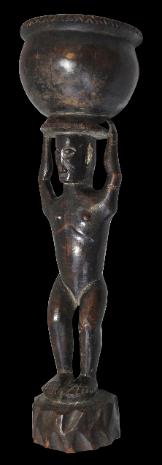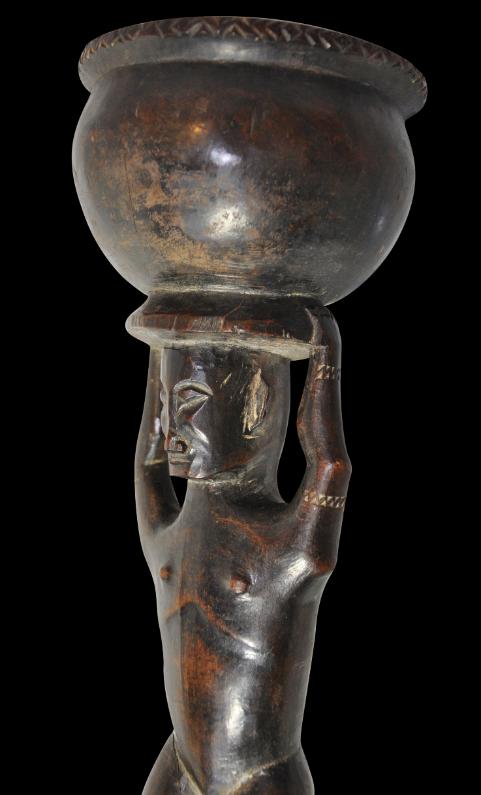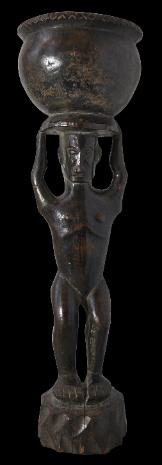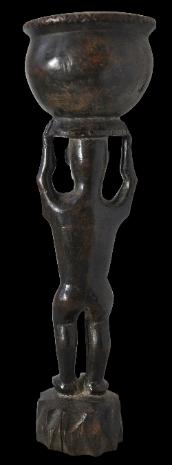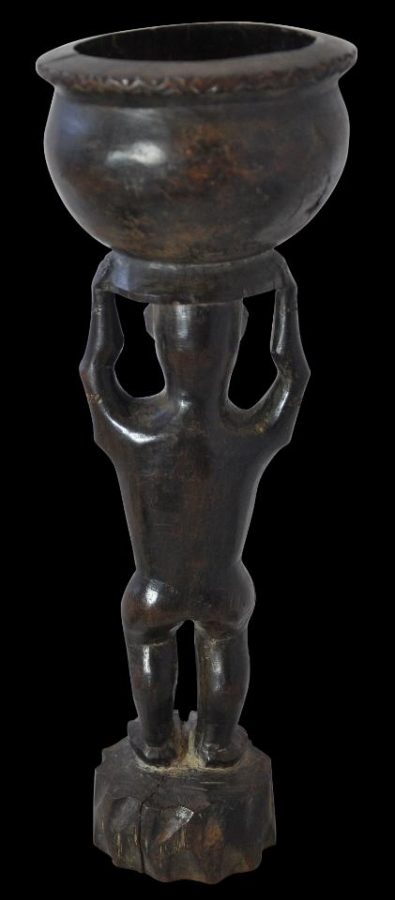This very fine example of a carved hardwood wine cup supported by a female ancestor figure in caryatid form comes from the Ifugao people of central Luzon island in the northern Philippines. It is exceptional for its rarity, sculptural quality and most particularly for its patina, which is dark, lustrous, deep and well developed.
The Ifugao served food and wine from footed bowls with notched rims. Such bowls also were used on ritual occasions to hold rice wine that was drunk by presiding priests (Casal, 1981, p. 202) in a ritual or canyaw.
This example was most probably carved to be used ritually. It features a female figure standing on a carved base. Her arms are stretched above her head to support a bowl (duyu) which is balanced on her head. The figure’s upper arms and wrists are carved with bands to denote tattoos. The more naturalistic handling of the figure, its facial features, and so on, suggest an early twentieth century dating when colonial influence saw the Ifugao carvers adopt more realistic features in their work.
Anderson (2010, p. 171) says that the hardwood used to carve duyus and other similar items developed superb, dark patinas over time.
Says Anderson (p. 172):
“In some cases, the duyu is supported by one or more anthromorphic figures. Such examples are extremely rare, and some of the few existing old examples lack signs of extensive use, a fact that has led to speculation about their actual existence as ritual objects. However, among others, the example collected during the 1870s (now in the collection of the Museo Nacional de Antropologia, Madrid) shows considerable wear and indisputably proves that these spectacular objects were indeed used as wine servers, and are not mere decorative items.”
A wine server of similar form but without the dark patina is illustrated in Anderson (2010, p. 174.) That example was collected in the 1880s and is now in the Museum fur Volkerkunde, Dresden. It is ascribed to the Kalanguya people, a sub-group of the Ifugao.
The item here is in excellent condition. As can be expected, it has some minor, old, age-elated shrinkage cracks. There are no chips or other losses, and no repairs. It stands solidly and in a stable manner.
References
Afable, P., et al, Philippines: an Archipelago of Exchange, ACTES SUD/ Musee du Quai Branly, 2013.
Casal, G. et al, The People and Art of the Philippines, UCLA Museum of Cultural History, 1981.
Labrador, A.M.T.P., ‘Review ofIn the Shape of Tradition‘, Arts of Asia, January-February 2011.
Anderson, E. M., In the Shape of Tradition: Indigenous Art of the Northern Philippines, C. Zwartenkot Art Books, 2010.
Palencia, J., ‘The dancing gods of Kiangan’, Arts of Asia, January-February 2012.


